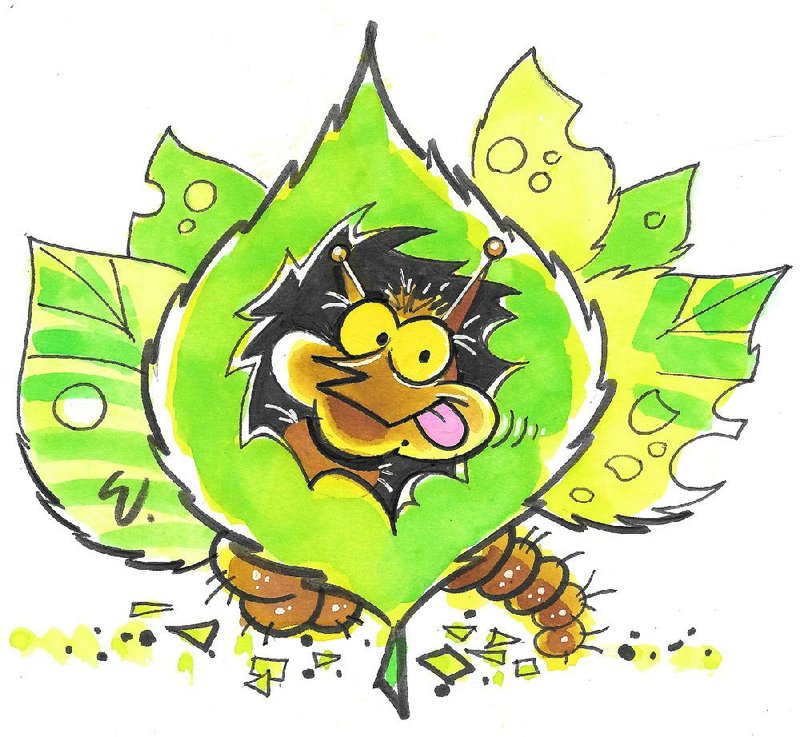Q I bought some red, yellow and orange bell peppers, but everything so far has turned out green. Do I need to leave them on longer before picking them or what?
A All peppers will start out green and as they mature they will turn yellow, orange or red. It often seems to take forever for the first peppers to start turning, but they will. Even the traditional green peppers will turn red if left on the plant long enough.
Q I had a very nice batch of mint that was very healthy and fragrant. Then I came home one day from work and many of the leaves were missing. From magnificent to miserable in 24 hours! I saw black "droppings" on some of the remaining leaves. A few days later I saw a hummingbird flying around near my mint. Do you think the hummingbird is the culprit?
A Wow! I think you have an impressive case of caterpillar damage. The "hummingbird" you saw was probably a hummingbird moth or sphinx moth. They closely resemble a hummingbird, but they lay eggs from which hornworm caterpillars emerge. They are voracious eaters and one of the largest caterpillars we have in the garden. The tomato hornworm is one of the most common of these pests, but there are several species. I have never known them to like mint, and most herbs usually are pretty care-free, but from the number of droppings you have, I would say you had a family of caterpillars. They tend to hide themselves very well on the undersides of the leaves or stems, but if you look closely when they are feeding, you should be able to find them. Once they are large, they are hard to kill, but picking them off and squishing them will work. I would clean up the plants, cutting them back. Since it is mint, it will be back in no time. Monitor the plants carefully as there can be more than one generation of the hornworm or sphinx moths per year.
Q I bought a bougainvillea in full bloom from Kroger in the spring. The blooms lasted a while and then fell off. Now all I have is a lot of foliage and no buds. I repotted it and have fed it. It gets afternoon sun.
A I suspect you have given it too much care. If you moved it into a much larger container, it is busily growing and putting on new roots. This can often interfere with flowering. Ignore it a bit -- let it get a bit dry, don't fertilize. Let things slow down. Hopefully it will begin to bloom. Don't take it too far and kill the plant with neglect, but they often bloom better in a smaller container.
Q I have two "Endless Summer" (I think that is the name) re-blooming hydrangeas. They are 4 to 5 years old. They have always been covered in blooms even after they had been frozen back to the ground. They are fully grown and very healthy looking except they have no flowers. Doesn't even look like any are even starting. What could be the problem? They were blue the first year or so, but are now pink. What is the easiest way to turn them blue again?
A For most gardeners in the central and southern parts of the state it has been a spectacular year for the big leaf hydrangeas. Those of you in the northern tier who got the late cold snap (and snow in some cases) in March did have some damage, and therefore few flowers. It would have limited the first blooms, but the re-blooming types like "Endless Summer" should be in bloom or at least beginning to bloom now. Make sure you are not fertilizing too much as you can encourage too much foliage growth at the expense of flowers. Also check the amount of shade they get. Even though big leaf hydrangeas won't do well in full afternoon sun, they do need some sunlight in the morning or filtered light through the day to set flowers. If your trees are getting larger and producing more shade, that could be a problem. The blue color is a result of an acidic soil pH, while pink comes when soil is more alkaline. Wettable sulfur or aluminum sulfate used as your fertilizer can help to get them bluer, but again, use caution as to how often you are fertilizing.
DEAR READERS: I have had several readers write in after a recent column about the pesky gnats. Many reported using a concoction of vanilla extract. Some just rub it on out of the bottle, while others mix it with water in a 1:4 ratio in a spray bottle. They report no gnats and they smell good as well.
Janet B. Carson is a horticulture specialist for the University of Arkansas Cooperative Extension Service. Write to her at 2301 S. University Ave., Little Rock, Ark. 72204 or email her at
HomeStyle on 07/08/2017

